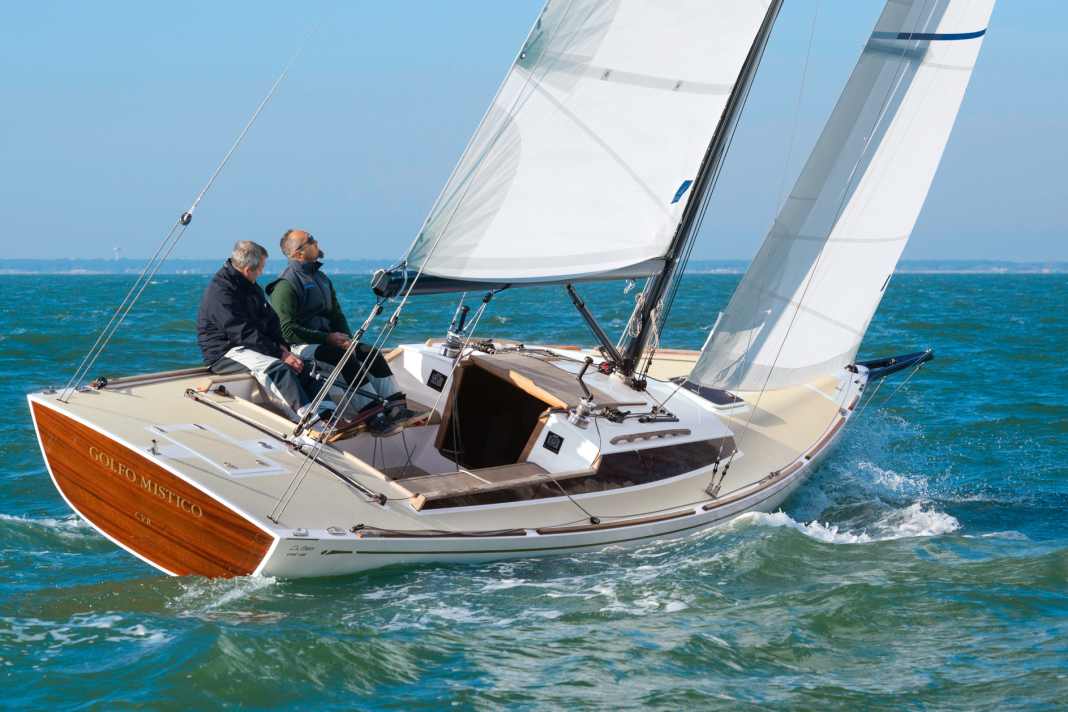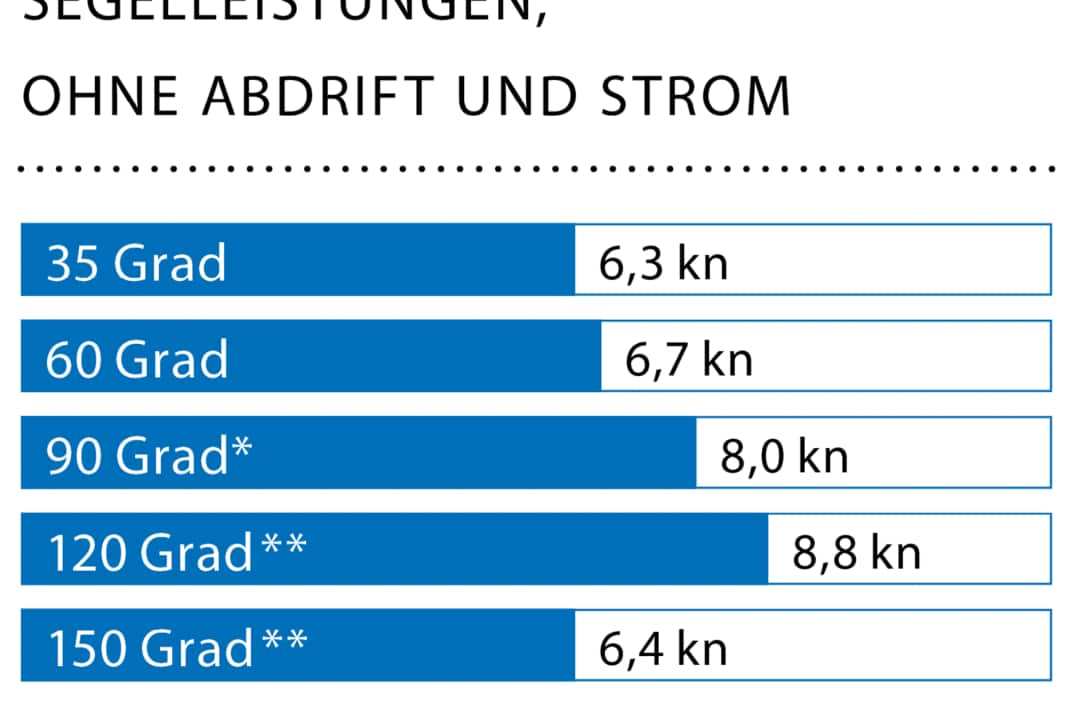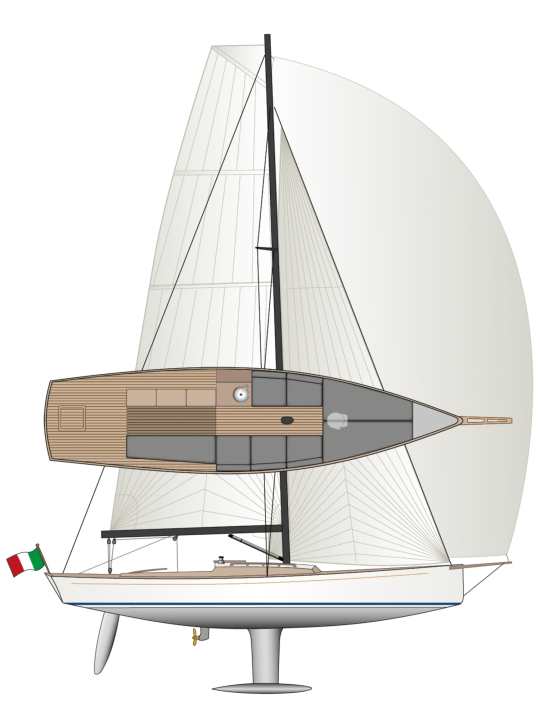De Cesari 33: So simple, so different, so beautiful - the weekender in the test






The entrance to the shipyard is difficult to find. There is no company sign, not even a letterbox. Only a small, inconspicuous back door in a tall and unsightly industrial façade leads into the hallowed halls of Italian boatbuilding. In Cervia near Ravenna on the Adriatic coast, the De Cesari shipyard has been building and restoring wooden boats for more than 70 years - using only natural materials. There is no gluing, laminating or levelling here, but rather sawing, planing and sanding, using good traditional craftsmanship. Shipyard boss Paolo de Cesari still attaches great importance to this. His father Adriano founded the company in 1947 and initially built racing motorboats with great expertise, later also building regatta yachts to individual order.
Also attractive and special:
The designer Giovanni Ceccarelli has developed a design for the shipyard: a ten metre long weekender that can also be transported on a conventional trailer on the road thanks to its width of just 2.55 metres.
The lines of the De Cesari 33 are classic, with a positive yacht stern, pronounced deck projection, long hull overhangs and a vertically sloping bow stem. The modern design of the flat underwater hull with its slender and deep appendages and a torpedo-shaped ballast body on the keel fin is completely different. The harmonious combination of tradition and modernity is powered by a comparatively high and powerful rig with ample sail area.
With a lot of temperament
The design parameters promise sportiness and performance. The sail load factor is quite high at 5.1, even though the wooden boat with a total weight of 3.3 tonnes cannot exactly be described as light in comparison with competitor boats built from GRP. However, it is not the design that is responsible for the extra weight, but rather the high ballast content of an impressive 40 per cent (1350 kilograms keel weight). This is necessary because the Italian is unusually slim with an aspect ratio of almost 4:1 and therefore has little inherent dimensional stability.
During the test run on the Adriatic off Ravenna, however, neither the comparatively high weight nor a supposed lack of dimensional stability had a detrimental effect on the sailing characteristics - quite the opposite. In perfect test conditions with 14 knots of wind and a long swell of around one metre, the pretty Italian shows what she is made of. And that's quite a lot. A speed of 6.3 knots upwind and, above all, a tacking angle of just 70 degrees are impressive. And the slim boat has no problems with the waves either. The full-bodied bow sets in softly and displaces well. Water coming over the stern in the cockpit is not an issue, even when the swell is higher at times.
Properly trimmed, the De Cesari 33 sails stiffly and very balanced. Nevertheless, steering remains challenging because even the smallest movements on the tiller cause immediate reactions. Although this is fun, it also requires a lot of attention from the helmsman. The boat also demonstrates its exceptional dynamism when manoeuvring under engine power in the harbour. Even at low speed and with little thrust from the propeller, it can almost be turned on its disc. The reactions when accelerating forwards and backwards are exceptionally direct.
The manoeuvrability is partly a result of the long hull overhangs at the stern and bow and the comparatively very short waterline in the neutral swimming position. This is only 7.90 metres with a hull length of exactly ten metres. The short immersion length also has advantages for measuring. The ratings are already available. According to ORC, the De Cesari 33 (the test boat) has a handicap of 627.3 GPH; according to IRC, the equalisation is 1.030 TCC.
Sporty or tamed
The owner of construction number 1 is an ambitious regatta sailor who wants to compete with his boat in the Mediterranean in the classic "Spirit of Tradition" classification. To do so, he has to equip his boat with a white Dacron wardrobe. The mainsail is fully battened and heavily flared at the top.
This makes double backstays necessary, with which the rig and thus also the sag in the forestay can be trimmed very effectively. However, the stays must be operated for every tack and jibe. The sheet clamps for coarse and fine adjustment on the aft cockpit bulkhead are very awkward and can only be reached with a lot of effort; there is still room for improvement here. The deflection for the mainsheet on the cockpit floor is also almost impossible to operate and the clamp there is ineffective. In addition, the mainsheet, which only has a triple ratio, requires a lot of force to tighten. Fine adjustment via an additional tackle would undoubtedly be feasible and desirable as standard.
Sailors who attach less importance to sportiness and regatta potential and prefer to travel comfortably alone or in pairs can have the De Cesari 33 equipped with a conventional mainsail and a central backstay. A self-tacking jib is also available as an alternative to the short overlapping genoa. However, a carbon fibre rig from Axxon is available on the list of options to increase performance; the shipyard charges an additional fee for this.
Diesel or electric
The cockpit with its long thwarts is large enough for up to four or five people to sail and enjoy themselves comfortably and with sufficient space. The cockpit is comparatively deep and this area is also quite well protected thanks to the full-length coamings. If you are planning longer trips with the boat, a continuous railing with bow and stern baskets can also be fitted on request, which upgrades the CE design category from C (close to shore) to B (far from shore).
There is plenty of storage space on deck. For example, sheets, mooring lines or additional sails can be stored underneath the long bench seat on the port side of the cockpit. However, the port side lockers are very poorly ventilated; water and moisture quickly accumulate here, which is something that should be avoided at all costs, especially on a wooden boat. Bulky items such as fenders, tarpaulins or the bathing ladder are stored in the huge aft locker, where they are easily and quickly accessible.
As standard ex shipyard, the De Cesari 33 is equipped with a two-cylinder Yanmar built-in engine with saildrive. The small, handy unit is accessible under a hatch in the cockpit floor and could be completely removed with comparatively little effort in the event of a fault. The machine can also be accessed for maintenance and inspection through a flap behind the removable steps on the companionway. Under full load, the drive pushes the boat up to a speed of 6.6 knots in smooth water. As an alternative to the combustion engine, the customer can also order the boat with an electric drive from Mastervolt with pod and lithium batteries. The surcharge for this is around 11,000 euros.
Old school
Apart from the rigging components, the keel, the cushions and some on-board technology, there are hardly any parts of the De Cesari 33 that are not made of wood. The hull is glued over a frame, with two layers of okumé diagonally and one layer of mahogany lengthways. This layer structure is 14 millimetres thick throughout and is then covered with a thin layer of GRP and epoxy resin. The load-bearing ring frames and the longitudinal mahogany mouldings are retained in the fuselage, only the shaping mouldings are removed.
The deck is constructed from conventional marine plywood and finished with a thin mahogany veneer on the inside to ensure a uniform look below deck.
And it is truly breathtaking. Bare precious wood wherever you look, impeccably matt lacquered, no colours, no inner shells, no plastic parts. And nowhere in the boat can you see any glue or remnants of joint sealant. The furniture and structural parts fit together without any gaps. The interior fittings in particular are an example of great craftsmanship. Not many shipyards still build boats with this much skill and passion in the old-school style.
The living space below deck remains manageable. With a length of 2.15 metres and a width of 1.60 metres at shoulder height, the double berth in the foredeck is large enough for two people to sleep comfortably. Another person can sleep on the long sofa on the starboard side. The scope of delivery also includes a chemical toilet, which is inconspicuously installed under the bunk boards of the forward berth and can be used with a flap that opens there. The only thing missing below deck is ventilation. There are no windows in the superstructure, which means that there is not only a lack of fresh air inside, but also a lack of light. What a pity.
Temptation for individualists
The De Cesari shipyard is offering its new 33-footer for a price of 177,000 euros (as of 2021). This corresponds to the gross price including 19 per cent VAT for the largely ready-to-sail standard boat with antifouling paint and including the ready-to-sail handover. However, the sails are still missing, which are not specified in the shipyard standard. Another 9,000 euros must be added for a simple upwind wardrobe. In addition, at least a gennaker or a code zero are almost mandatory as part of the concept.
A comparative look at the competition shows that the price structure is high, but it is still difficult to categorise because there is hardly anything comparable on the market with regard to the very exclusive and high-quality wooden construction. One thing is clear: if you are interested in an individual daysailer or weekender with a hull length of around ten metres and are looking for something very special, you will have to take a look at the De Cesari 33. And it's definitely worth it.
The measured values for testing the De Cesari 33




The De Cesari 33 in detail

Technical data of the De Cesari 33 in detail
- Designer: G. Ceccarelli
- CE design category: C/B
- Torso length: 9,99 m
- Width: 2,55 m
- Depth: 2,00 m
- Weight: 3,3 t
- Ballast/proportion: 1,35 t/40 %
- Mainsail: 34,1 m2
- Furling genoa (106 %): 23,7 m2
- machine (Yanmar ): 13 kW/18 hp
Hull and deck construction
Hull moulded with epoxy (2 layers okumé, 1 layer mahogany), covered with GRP. Deck made of plywood
Price and shipyard
- Base price ex shipyard: 177.300 €
- General guarantee: 5 years
As of 2021, how the prices shown are defined can be found here!
Shipyard and distribution
Cantiere Navale de Cesari S.N.C., I-48015 Cervia Milano Marittima; www.cantierenavaledecesari.it
YACHT review of the De Cesari 33
This beautiful and harmonious week- ender comes from a traditional yacht-building factory in Italy and is made entirely of wood. The design by Giovanni Ceccarelli also shows its advantages under sail
Design and concept
- + Attractive appearance
- + Exclusive timber construction
- - Upscale price
Sailing performance and trim
- + Runs high and stiff in the wind
- + High dynamics, lots of agility
- + Efficient trimming devices
Living and finishing quality
- + Beautiful interior design
- - Little light and air below deck
Equipment and technology
- + Good, complete deck equipment
- + Electric motor as an option
- - Some fittings difficult to reach
The test first appeared in YACHT issue 05/2021 and has been revised for the online version.

